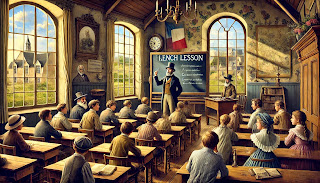By William Douglas
Short Answer Type Questions
1. Why does the author recall his childhood experience at the YMCA pool?
Answer: The author recalls his near-drowning experience at the YMCA pool to highlight his lifelong fear of water and his eventual triumph over it. The incident marks a turning point, underscoring the deep psychological impact of trauma and the importance of confronting one's fears.
2. If you were asked to depict the pool incident as a graphic story, which details would you emphasize?
Answer: I would highlight the terror of being pushed into the pool, the vivid sensory descriptions of water suffocating the author, and the moment of near surrender. These elements would visually capture the intensity of his struggle and his ultimate determination to overcome fear.
3. How can William Douglas’s experience with overcoming fear inspire students today?
Answer: Douglas’s experience teaches students that fear is not insurmountable. By persistently working to overcome his fear of water, he demonstrates that resilience, practice, and determination can help individuals tackle even their deepest insecurities, a lesson applicable in academic and personal challenges.
4. How effective is William Douglas’s use of vivid imagery in describing his near-drowning experience?
Answer: Douglas’s vivid imagery effectively conveys his panic and helplessness during the near-drowning incident. His detailed sensory descriptions, such as “paralysis gripping my body,” allow readers to empathize with his ordeal, making the narrative emotionally powerful and relatable.
5. What role does the YMCA pool incident play in the overall narrative of Deep Water?
Answer: The YMCA pool incident is central to the narrative, as it establishes the author’s deep-seated fear of water. This pivotal episode motivates his eventual journey of overcoming the fear, symbolizing resilience and marking his personal transformation.
6. What can you infer about William Douglas’s personality based on his decision to conquer his fear of water?
Answer: Douglas demonstrates determination, courage, and a strong will to overcome adversity. Despite repeated failures and setbacks, he does not give up. His perseverance in conquering his fear shows a commitment to self-improvement and personal growth.
7. How does Douglas’s description of his struggle resonate with the universal human experience of facing fears?
Answer: Douglas’s struggle resonates universally as everyone faces fears that challenge their confidence. His description of panic, despair, and eventual triumph mirrors the emotional journey many experience when overcoming obstacles, making his story relatable and inspiring.
8. How did the swimming coach contribute to Douglas’s journey of overcoming his fear?
Answer: The swimming coach played a vital role by teaching Douglas swimming techniques in a systematic and supportive manner. His guidance helped Douglas regain confidence in the water and gradually build the skills and mindset needed to conquer his fear.
Long Answer Type Questions
1. How does Deep Water convey the importance of persistence in overcoming personal fears? Relate it to a challenge faced by individuals in the modern world.
Answer:
In Deep Water, William Douglas illustrates how persistence and determination enabled him to overcome his crippling fear of water. Despite a terrifying childhood experience, he took deliberate steps to confront his fear by hiring a swimming coach and practicing consistently. His journey shows that courage is not the absence of fear but the resolve to face it repeatedly until it no longer dominates one’s life.
In today’s world, individuals face numerous challenges, such as public speaking anxiety, career setbacks, or adapting to technological changes. Douglas’s narrative is a reminder that success often requires perseverance and incremental progress. For example, someone afraid of public speaking might start by practicing in front of friends before addressing larger audiences. His story inspires readers to tackle challenges methodically, recognizing that persistence can transform fears into strengths, much like his triumph over water.
2. Evaluate the writing style of William Douglas in Deep Water. How does his use of vivid imagery and reflective tone enhance the narrative’s impact on readers? Connect this with its relevance to mental health awareness.
Answer:
William Douglas’s writing style in Deep Water combines vivid imagery and a reflective tone to immerse readers in his harrowing experience. His detailed descriptions of drowning, such as the suffocating sensation and the “yellow tinge of water,” vividly recreate the scene, enabling readers to empathize with his terror. The reflective tone adds depth, allowing readers to understand the psychological toll of fear and the resilience needed to overcome it.
This narrative’s impact extends beyond a personal story, as it resonates with mental health struggles like anxiety or post-traumatic stress. Just as Douglas faced his fear of water step by step, individuals can address mental health challenges by seeking guidance, practicing coping strategies, and remaining patient. His journey underscores the importance of persistence and support in recovery, inspiring readers to approach mental health with empathy and resilience.



